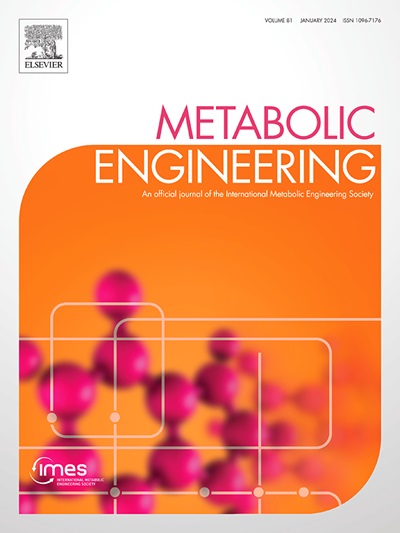NEXT-FBA: A hybrid stoichiometric/data-driven approach to improve intracellular flux predictions
IF 6.8
1区 生物学
Q1 BIOTECHNOLOGY & APPLIED MICROBIOLOGY
引用次数: 0
Abstract
Genome-scale metabolic models (GEMs) have been widely utilized to understand cellular metabolism. The application of GEMs has been advanced by computational methods that enable the prediction and analysis of intracellular metabolic states. However, the accuracy and biological relevance of these predictions often suffer from the many degrees of freedom and scarcity of available data to constrain the models adequately. Here, we introduce Neural-net EXtracellular Trained Flux Balance Analysis, (NEXT-FBA), a novel computational methodology that addresses these limitations by utilizing exometabolomic data to derive biologically relevant constraints for intracellular fluxes in GEMs. We achieve this by training artificial neural networks (ANNs) with exometabolomic data from Chinese hamster ovary (CHO) cells and correlating it with 13C-labeled intracellular fluxomic data. By capturing the underlying relationships between exometabolomics and cell metabolism, NEXT-FBA predicts upper and lower bounds for intracellular reaction fluxes to constrain GEMs. We demonstrate the efficacy of NEXT-FBA across several validation experiments, where it outperforms existing methods in predicting intracellular flux distributions that align closely with experimental observations. Furthermore, a case study demonstrates how NEXT-FBA can guide bioprocess optimization by identifying key metabolic shifts and refining flux predictions to yield actionable process and metabolic engineering targets. Overall, NEXT-FBA aims to improve the accuracy and biological relevance of intracellular flux predictions in metabolic modelling, with minimal input data requirements for pre-trained models.
NEXT-FBA:一种混合化学计量学/数据驱动的方法,用于改善细胞内通量预测。
基因组尺度代谢模型(GEMs)已被广泛用于了解细胞代谢。GEMs的应用已经通过能够预测和分析细胞内代谢状态的计算方法得到了推进。然而,这些预测的准确性和生物学相关性经常受到许多自由度和可用数据稀缺的影响,无法充分约束模型。在这里,我们引入NEXT-FBA(神经网络细胞外训练通量平衡分析),这是一种新的计算方法,通过利用外代谢组学数据来获得GEMs细胞内通量的生物学相关限制,从而解决了这些限制。我们通过使用中国仓鼠卵巢(CHO)细胞的外代谢组学数据训练人工神经网络(ann),并将其与13c标记的细胞内通量组学数据相关联,实现了这一目标。通过捕获外代谢组学和细胞代谢之间的潜在关系,NEXT-FBA预测细胞内反应通量的上限和下限,以约束GEMs。我们通过几个验证实验证明了NEXT-FBA的有效性,在预测与实验观察密切相关的细胞内通量分布方面,它优于现有方法。此外,一个案例研究展示了NEXT-FBA如何通过识别关键的代谢变化和改进通量预测来指导生物过程优化,从而产生可操作的过程和代谢工程目标。总的来说,NEXT-FBA旨在提高生物过程优化代谢模型中细胞内通量预测的准确性和生物学相关性,对预训练模型的输入数据要求最小。
本文章由计算机程序翻译,如有差异,请以英文原文为准。
求助全文
约1分钟内获得全文
求助全文
来源期刊

Metabolic engineering
工程技术-生物工程与应用微生物
CiteScore
15.60
自引率
6.00%
发文量
140
审稿时长
44 days
期刊介绍:
Metabolic Engineering (MBE) is a journal that focuses on publishing original research papers on the directed modulation of metabolic pathways for metabolite overproduction or the enhancement of cellular properties. It welcomes papers that describe the engineering of native pathways and the synthesis of heterologous pathways to convert microorganisms into microbial cell factories. The journal covers experimental, computational, and modeling approaches for understanding metabolic pathways and manipulating them through genetic, media, or environmental means. Effective exploration of metabolic pathways necessitates the use of molecular biology and biochemistry methods, as well as engineering techniques for modeling and data analysis. MBE serves as a platform for interdisciplinary research in fields such as biochemistry, molecular biology, applied microbiology, cellular physiology, cellular nutrition in health and disease, and biochemical engineering. The journal publishes various types of papers, including original research papers and review papers. It is indexed and abstracted in databases such as Scopus, Embase, EMBiology, Current Contents - Life Sciences and Clinical Medicine, Science Citation Index, PubMed/Medline, CAS and Biotechnology Citation Index.
 求助内容:
求助内容: 应助结果提醒方式:
应助结果提醒方式:


